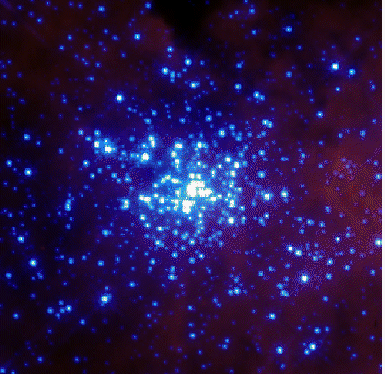For more than a century, it was thought that there exist only two types of clusters --- Open Clusters and Globular Clusters (GCs). The former are blue, relatively young (<1 Gyr) and found in the galactic disk, whereas the Globular Clusters are red, old (5-10 Gyr) and occupy the halo. However, the impecable spatial resolution of the Hubble Space Telescope (HST) has resulted in the discovery of a third class of stellar clusters, that are compact like the Globular Clusters, but are blue like the Open Clusters. These are the Compact star clusters or more popularly known as Super Star Clusters (SSCs). Starburst galaxies, such as M82 host hundreds of them. We are carrying out a study of these clusters in M82 and other nearby galaxies. The questions that we aim to address in these studies are:
|

One of the very few resolved SSCs: R136 at the center of 30 Doradus in the LMC |
Have you heard of a road accident between two cars converting one of them into a more attractive car? Well, there is one type of cosmic collision where such a thing happens --- a head-on collision between a spiral galaxy and a compact elliptical or a spheroidal galaxy, results in a galaxy with a beautyful ring, known as a ring galaxy. A crude analogy is the formation of an expanding circular wave (or ring) in a pond when a stone is dropped into it. Unlike a pond, where the matter (i.e. water) is completely in fluid form, a spiral galaxy contains much more matter that moves as rigid particles (i.e. stars) as compared to a fluid (i.e. gas). The intruder, an elliptical galaxy, shares some similarities with a stone, in the sense that it lacks fluid particles. Nevertheless, the bond between the stars (gravitational) is not as strong as the bond between the stone particles (molecular). In addition, there are second order effects, such as the compression caused of the expanding waves producing a flash of light in form of star formation. All these differences ensure that a ring galaxy is not just an astronomically giant pond wave, and instead is much more interesting to observe and study. The study of ring galaxies basically involves interpreting their presently observed structure in the frame work of the head-on collisional model. The most attractive and famous of the ring galaxies, the Cartwheel, quite well fits the basic scenario. Nevertheless, there are details that needs further study. In particular, our study is focussed addressing the following questions:
|

HST image of the Cartwheel |
- Density Gradients and Internal Dust in the Orion Nebula
Binette, L.; González-Gómez, D. I., & Mayya, Y. D. 2002, Rev Mex de Astronomía y Astrofísica 38, 279 - Use of Red supergiant spectral features as age indicators in
starburst regions
Mayya, Y.D. 1997, ApJL, 482, L149 | HTML | astro-ph | postscript.gz - Embedded Clusters in Giant Extragalactic HII Regions:
III. Extinction and Star Formation
Mayya, Y.D., & Prabhu, T.P. 1996, AJ, 111, 1252; - Embedded Clusters in Giant Extragalactic HII Regions:
II. Evolutionary Population Synthesis Model
Mayya, Y.D. 1995, AJ, 109, 2503; ====> data tables - Embedded Clusters in Giant Extragalactic HII Regions:
I. BVRH_alpha Photometry
Mayya, Y.D. 1994, AJ, 108, 1276; ====> data tables
Thesis projects - Ricardo Retes - Master's from INAOE (2008) "Embedded Young stellar population in the Galactic Molecular cloud associated with the source IRAS 18236-1205"
Publications:
-
The Star Formation History of the Disk of the
Starburst galaxy M82
Y. D. Mayya, A. Bressan, L. Carrasco, and L. Hernandez-Martinez
The Astrophysical Journal, 649, 172-180, 2006 | astro-ph/0605669 -
The Discovery of Spiral Arms in the Starburst Galaxy M82
Y. D. Mayya, L. Carrasco, A. Luna
ApJ, 628:L33-L36, 2005 July 20 | astro-ph/0506275 | Web Release -
Star Formation History and Extinction in the central kpc of M82-like Starbursts
Mayya, Y. D. , Bressan, A., Rodriguez, M., Valdes, J.R., and Chavez, M. 2004, ApJ, 600, 188 - Near infrared and Optical morhology of the dusty galaxy NGC972
Mayya, Y. D., Ravindranath S. and Carrasco, L. 1998, AJ, 116, 1671 | astro-ph/9808008 | postscript.gz - Spatial Distribution of Far infrared emission in Spiral galaxies: I. Relation with Radio continuum emission
Publications: